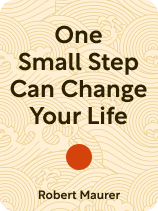

This article is an excerpt from the Shortform book guide to "One Small Step Can Change Your Life" by Robert Maurer. Shortform has the world's best summaries and analyses of books you should be reading.
Like this article? Sign up for a free trial here.
Are you eager to make a change in your life but can’t seem to make progress due to fear? Does uncertainty hold you back from your goals?
According to clinical psychologist Robert Maurer, one small, achievable action is all it takes to overcome these obstacles and make change happen. In his book One Small Step Can Change Your Life, he unravels why it’s often hard to make changes: Change triggers your fight-or-flight response.
Continue reading for our overview of One Small Step Can Change Your Life by Robert Maurer.
1-Page Summary
In the book One Small Step Can Change Your Life, Robert Maurer presents simple and effective strategies that will empower you to move forward and achieve your goals. This overview walks you through Maurer’s insights into the kaizen technique. You’ll come away knowing how to transform seemingly daunting goals into enjoyable and attainable ones. We’ll explore Maurer’s ideas in two parts:
- Part 1 clarifies why change is difficult and how taking small actions helps overcome this difficulty.
- Part 2 presents six quick and effective strategies that will empower you to make the changes you want.
Robert Maurer is the Director of Behavioral Sciences for the Family Practice Residency Program in Spokane, Washington, and a faculty member of the UCLA School of Medicine and the University of Washington School of Medicine. He has authored several influential books, including Mastering Fear and The Spirit of Kaizen. His work as a corporate consultant introduced him to kaizen, a Japanese philosophy that advocates continuous improvement through small, consistent steps. Inspired by the effectiveness and simplicity of this approach, Maurer has since helped many organizations—including Walt Disney, The Make-Wish Foundation, and the US Navy—to leverage kaizen for progressive improvement.
Part 1: Why Small Actions Are Key to Big Life Changes
To understand why small actions are key to implementing change, we’ll first explain how your fight-or-flight response makes change difficult. Then, we’ll clarify how taking small actions helps you sidestep this instinctive response and progress steadily toward your goals.
Change Triggers Your Fight-or-Flight Response
According to Maurer, change is often difficult to implement because it triggers your fight-or-flight response, a vestige of evolution. To ensure survival, your ancestors had to constantly stay alert to danger so that they could react swiftly to threats in their environment. Hundreds of years later, though the environment is now less threatening, your instinct to avoid danger hasn’t evolved. However, instead of protecting you from threats to your survival, this instinct now sets off alarm bells whenever you attempt to depart from your habitual, safe routine. In other words, your brain perceives any change, from major life changes to minor habit adjustments, as a threat.
Maurer explains that this involuntary response hinders change in two ways: First, in fight-or-flight mode, your brain prioritizes instinctual survival responses (fight, flight, or freeze) to guide you toward safety. This process shuts down the parts of your brain responsible for conscious thought and problem-solving, which impedes your ability to think clearly, plan effectively, and make the rational decisions necessary for implementing change. For example, when considering a career change, you might find yourself frozen by indecision rather than being able to logically weigh the pros and cons.
The fight-or-flight response also induces fear. The larger the change and the more it matters to you, the stronger the fear you feel. This fear can be deeply uncomfortable, leading you to resist change and default to familiar routines that sabotage your efforts. For example, you may want to adopt a healthier lifestyle—but find yourself reaching for junk food and skipping the gym to avoid the discomfort that comes from stepping out of your comfort zone.
Small Actions Bypass Your Fight-or-Flight Response
Does your inevitable fight-or-flight response to change mean that you’re forever bound to suffer from cognitive resistance and fear when attempting change? Fortunately, this doesn’t have to be the case. Maurer suggests a way to bypass your fight-or-flight response and embrace change with confidence and ease: Take very small, incremental actions toward your goals.
Taking small, easy actions enables you to sneak past your internal alarm system, preventing your fight-or-flight response from kicking in. This allows the parts of your brain responsible for conscious thought and problem-solving to stay active and engaged and diminishes the fear that typically accompanies the process of change.
Beyond these immediate benefits, Maurer says that this incremental approach supports your ability to implement change by helping you to:
Build momentum: While small actions may seem inconsequential, their impact lies in their cumulative effect. Because they’re so easy to achieve, they pave the way for further actions that keep you moving toward larger achievements. For example, perhaps you want to be more organized. Decluttering one drawer feels so easy and satisfying that you decide to tackle your closet, gradually building the momentum to organize your entire house.
Establish new behaviors: With each small action, you gently reduce your resistance to new ways of thinking and behaving. Over time, these new thoughts and behaviors become second nature, replacing old patterns with minimal friction. For example, let’s say you want to cut out unhealthy beverages. Introducing one glass of water into your morning routine soon feels so natural and beneficial that you automatically start choosing water over sugary drinks throughout the day.
Maurer argues that these benefits lead to a profound shift in how you experience change: What once felt daunting to you becomes enjoyable and achievable, and you feel empowered to progress toward your goals.
Part 2: How to Take Small Actions to Change Your Life
Now that we’ve covered why small actions are key to implementing change, let’s explore how to apply them to your goals. Maurer recommends six strategies: Question what to do next, visualize your success, act incrementally, resolve minor issues, reward your efforts, and notice subtle details. Let’s look at what each of these strategies entails.
Strategy #1: Question What to Do Next
Regularly ask yourself non-threatening questions that lead to solutions. According to Maurer, questions catalyze change by engaging the problem-solving regions of your brain. When you pose a question, your brain takes it as a cue to seek out answers, which shifts your attention away from reasons not to change and toward potential ways you can make change happen.
Maurer emphasizes the need to frame your questions in a way that doesn’t trigger your fight-or-flight response, which will hinder your ability to come up with solutions. For example, if your goal is to quit smoking, asking “How can I quit smoking today?” might provoke anxiety that exacerbates your resistance to change. On the other hand, asking a gentler question, such as, “What’s one way I can cut back on cigarettes this month?” is less likely to induce stress and more likely to elicit solutions.
To apply this strategy, Maurer recommends that you integrate questions into your daily routine. After formulating a question, commit to asking it every day—perhaps as part of your morning routine. This daily practice is crucial for three reasons:
- Your brain associates frequency with importance: The more you focus on a question, the more your brain interprets it as a priority and allocates resources to address it.
- Your brain enhances problem-solving with repetition: Repeatedly focusing on the same question encourages your brain to explore the issue from different angles and in greater depth, which can lead to more insightful and well-developed solutions.
- Your brain adapts through repetition: Over time, this ongoing practice reshapes how you think about change in general, fostering a mindset that automatically looks for ways to implement changes in other areas of your life.
Integrate Questions Into Your Routine
Maurer identifies several areas where non-threatening questions can be particularly effective in daily life, including:
- Overcoming self-criticism: Challenge negative self-talk by asking questions that acknowledge your achievements. For example, if you’re questioning your value at work, shift your perspective by asking, “What’s one contribution I made today?”
- Sparking creativity: Stimulate your imagination by focusing on small, specific aspects of your creative projects. For example, if you’re experiencing writer’s block with a piece of fiction, ask yourself, “What’s one character trait I can explore further?”
- Pursuing happiness: Identify what brings you joy by reflecting on daily activities. For example, if you’re unsure how to enhance your happiness, ask yourself, “What’s one simple thing that brought me joy today?”
- Achieving goals: Break down your goals into actionable steps with targeted questions. For example, if you want to eat healthier, ask, “What’s one vegetable I can add to my meals this week?”
- Resolving conflicts: Shift your perspective in conflicts by seeking to understand the other person’s point of view. For example, if you’re at odds with someone, ask yourself, “What’s one positive intention behind their actions?”
Strategy #2: Visualize Your Success
Asking non-threatening questions will generate ideas for implementing change. But what if you’re hesitant to act on these ideas? Maurer suggests that you mentally prepare yourself to move forward by visualizing the steps you want to take.
He explains that visualization is a form of mental rehearsal, readying your mind to adopt new skills and behaviors. It works because your brain can’t distinguish between real and vividly imagined experiences, which means it processes visualizations as if they’re actual experiences.
This technique is particularly useful for developing new skills because each visualization session encourages your brain to practice and refine the skills you’re imagining, much like physical practice. For example, visualizing yourself playing the piano can enhance your dexterity as effectively as if you were sitting at the keyboard for a lesson. And, Maurer says, with regular repetition, the actions you envision feel more familiar and natural, which makes it easier to perform them in the real world.
Integrate Visualization Into Your Routine
Maurer suggests that the key to effective visualization is repetition and gradual progression. He recommends the following process for integrating visualization into your routine:
- Select a task that you feel nervous about and allocate a few seconds each day to visualization.
- During each session, close your eyes and imagine yourself performing the task. Engage all of your senses—see, hear, smell, touch, and feel emotions just as if you were acting in real life.
- Imagine positive outcomes, such as successfully completing the task or receiving a favorable response from others.
- As you grow more comfortable, gradually increase the duration of your sessions. Then, start to weave in challenges, such as potential obstacles or worst-case scenarios, and visualize yourself managing them effectively.
Strategy #3: Act Incrementally
Once you’ve primed your brain for action, it’s time to take steps to make your desired changes a reality. Maurer says that the best way to move forward is to take actions that are so minute and effortless that they seem too trivial to count as progress.
Though small actions may seem trivial, they lead to significant progress because they’re easy to achieve and build upon one another. Beginning with one tiny action paves the way for larger subsequent actions. This incremental approach breaks down a daunting task into a series of manageable steps, creating momentum that ultimately leads to the change you’re seeking.
Integrate Actions Into Your Daily Routine
Maurer suggests that asking non-threatening questions (Strategy #1) uncovers specific actions you can take to facilitate the changes you want. To illustrate how small these actions should be, let’s look at examples of initial actions you might take:
- Overcoming self-criticism: After asking yourself “What’s one contribution I made at work today?”, you realize that you contributed valuable insights during a team meeting. You write down this contribution on a sticky note, so you can see and remember it later.
- Sparking creativity: Guided by the question “What’s one character trait I can explore further in my fiction writing?”, you discover an underdeveloped aspect of your character’s Irish heritage. You open up a playlist of traditional Irish ballads for inspiration.
- Pursuing happiness: Reflecting on the question “What’s one simple thing that brought me joy today?” helps you remember how much you enjoyed a quiet cup of coffee in the morning. You set your alarm for five minutes earlier so that you can savor your coffee in peace.
- Achieving goals: Upon considering “What’s one vegetable I can add to my meals this week?”, the enjoyable crunch of broccoli comes to mind. You add broccoli to your shopping list.
- Resolving conflicts: Pondering the question “What’s one positive intention behind their actions?” helps you understand that the other person might be trying to uphold a high standard of work. You note down one positive aspect of their work ethic.
Once you comfortably achieve your small step, Maurer recommends adding another small action to continue your progress.
Strategy #4: Resolve Minor Issues
Now that we’ve explored how to identify, prepare for, and initiate small actions, let’s move on to another strategy for implementing change: Resolve minor issues.
According to Maurer, tackling minor issues as they arise supports your efforts to implement change in two key ways:
- First, it prevents small problems from escalating into larger, more daunting challenges—for example, addressing minor accounting errors in your business can avert penalties during tax audits.
- Second, with every minor issue you successfully handle, your confidence grows, and this prepares you to handle more significant challenges. For example, addressing a minor disagreement with a friend can boost your confidence to handle major disputes in the future.
Tackling minor issues is particularly effective when you’re in the midst of a crisis and feel overwhelmed. Whether you’re suffering from an illness, dealing with a loss of income, or going through a breakup, you often can’t rectify the situation with a single, swift action. But if you focus on resolving minor problems during the crisis, you’ll gain a sense of control and start progressing slowly toward a solution. For example, if you’re feeling overwhelmed by debt, paying off your smallest bill will provide an immediate sense of accomplishment that may motivate you to tackle the next bill, and the next, until you clear all your debts.
Integrate Problem-Solving Into Your Routine
Maurer recommends three exercises for identifying and addressing minor issues in daily life:
1) Reflect on past difficulties. This will help you detect and respond to current issues that might hint at future challenges. To reflect effectively, start by recalling a major challenge you faced. Then identify any small issues that forecasted the challenge and, based on those issues, consider any steps you could have taken to avert it. For example, if your business failed, one early warning sign might have been a slight increase in product returns. Adjusting your business strategy based on this feedback might have kept your business afloat.
2) Identify minor mistakes: This will help you address your mistakes, which, in turn, will prevent larger problems from developing. To identify mistakes, think about a recent misstep you made. Consider whether this error indicates a broader problem or has the potential to become a larger issue if left unchecked. For example, perhaps you missed a work deadline, which might indicate bigger issues such as poor time management skills or procrastination habits.
3) Pay attention to warning signs: This will help you anticipate and prevent future challenges. To do this, think of a small annoyance or concern. Consider if it’s an early indicator of a larger problem that you might be able to avoid. For example, during a first date, your partner might continuously interrupt you, indicating a lack of respect. You may decide not to go on a second date to avoid more significant relationship issues down the line.
Strategy #5: Reward Your Efforts
Maurer says that you’ll find it easier to consistently practice the preceding strategies if you use small rewards to fuel your motivation.
He emphasizes that small rewards are more effective than large ones: Large rewards often spark intense pressure to do something really impressive to earn them. This pressure can misdirect your motivation, driving you to focus solely on earning the reward. As a result, once you have the reward, you don’t feel motivated to keep going.
On the other hand, small rewards don’t induce the pressure associated with grand pay-offs. Rather, they serve as tokens of recognition that validate your ongoing efforts and celebrate your progress. As such, they encourage you to engage in and appreciate the process of change—which motivates you to keep taking action.
For example, if you want to lose weight and set a large reward, like a vacation, for shedding 10 pounds, you might focus more on the vacation than on establishing healthy eating habits—which may lead you to adopt unhealthy measures such as crash dieting. As a result, once your trip’s over, you won’t have healthy eating habits to fall back on. However, if you reward yourself with something small, such as an extra five minutes of relaxation time, for each healthy choice you make, you’ll reinforce the process itself. This will help you establish and maintain long-term habits that support your goal.
Integrate Rewards Into Your Routine
Maurer offers four suggestions for integrating small rewards into your routine:
1) Reward your efforts and your results to stay invested in the process of working toward your goal. For example, if you want to write a book, reward yourself each time you complete a writing session, as well as each time you complete a chapter.
2) Keep rewards quick and simple so that you can immediately reward yourself after each step, which will reinforce the connection between the action and the positive feedback. For example, take a five-minute break or have a small treat after you complete the action.
3) Ensure the rewards align with your goal. For example, if you aim to save money, rewarding your prudent spending with a lavish shopping spree would be counterproductive. On the other hand, spending an evening with a favorite book or movie would support your efforts.
4) Personalize the rewards to motivate others to change. For example, if you want to reward your children for keeping their bedrooms clean, you’re more likely to encourage them to continue by thinking about what makes them feel appreciated, such as earning extra playtime.
Strategy #6: Notice Subtle Details
Maurer’s final strategy—notice small details—encourages you to be more mindful of day-to-day moments. Maurer explains that this attentiveness furthers your progression toward your goal by helping you to:
1) Uncover opportunities for improvement. Often, it’s the small details that hold the key to implementing meaningful changes. By noticing them, you become aware of habits or factors in your environment that you can adjust to facilitate your progress. For example, perhaps noticing how your squeaky office chair distracts your focus inspires you to invest in a higher-quality chair, improving both your focus and comfort.
2) Enjoy the process. It’s common to defer satisfaction until you finally reach your end goal. Paying attention to each moment allows you to acknowledge and appreciate every small accomplishment along your path, which generates a sense of satisfaction in the day-to-day process of change.
3) Maintain a positive outlook. It’s easy to get so caught up in pursuing a goal that you overlook potential moments of pleasure in everyday life. Making a conscious effort to be more aware helps you identify and savor these small moments of joy, which enhances your overall mood and happiness.
Integrate Noticing Small Details Into Your Routine
Maurer identifies three areas where noticing small details in daily life can benefit you:
- Your peace of mind: If you struggle with anxiety, noticing small details to appreciate can divert your attention and ease your apprehension. For example, if you’re feeling overwhelmed about a looming deadline, noticing the warmth of the sunlight through your window can provide a comforting contrast to your worries.
- Your relationships: If you feel like your loved ones are neglecting you or being distant, noticing the small ways they show care or affection can foster a sense of appreciation and connection. For example, acknowledging your partner’s effort to cook your favorite meal or a friend’s quick text to check on you can reinforce the supportive bonds you share.
- Your career: If you’re aiming to improve professionally or creatively, noticing small details can help you fine-tune nuances that enhance the quality of your work. For example, paying attention to subtle reactions from your clients can lead to crucial insights about their preferences.

———End of Preview———
Like what you just read? Read the rest of the world's best book summary and analysis of Robert Maurer's "One Small Step Can Change Your Life" at Shortform.
Here's what you'll find in our full One Small Step Can Change Your Life summary:
- Why it's often difficult to make the changes you want
- How to avoid your fight-or-flight response and move forward instead
- Simple strategies to transform seemingly daunting goals into enjoyable and attainable ones






